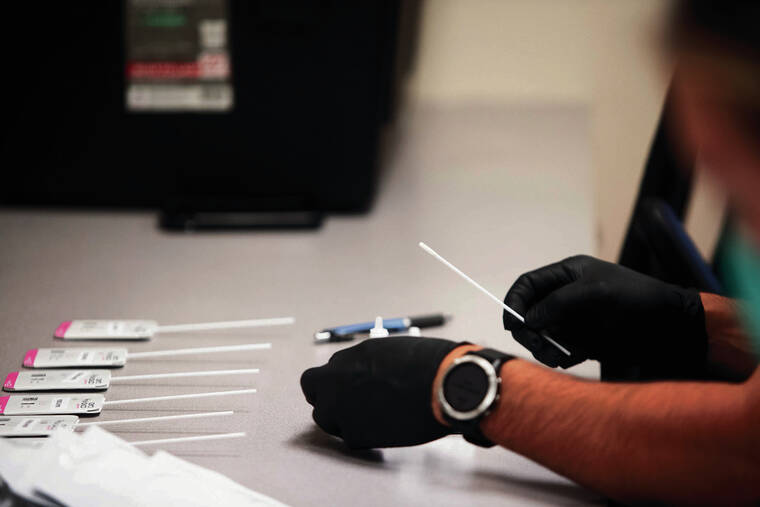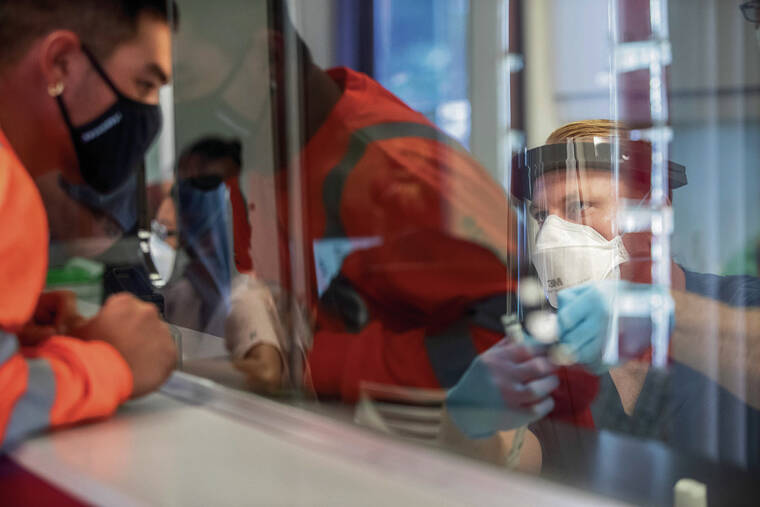Researchers say Hawaii Health Department officials have refused to share COVID-19 data

CINDY ELLEN RUSSELL / CRUSSELL@STARADVERTISER.COM
The Department of Health on Wednesday reported seven new coronavirus-related deaths and 168 new confirmed and probable infections statewide. A swab sample was prepared for a rapid COVID-19 test at the Waianae Coast Comprehensive Health Center’s Nanakuli clinic on Wednesday.

CINDY ELLEN RUSSELL / CRUSSELL@STARADVERTISER.COM
Hawaii Army National Guard Spc. Jordan Clapson instructed a patient on how to self-administer a COVID-19 test at the Waianae Coast Comprehensive Health Center’s Nanakuli clinic on Wednesday. WCCHC, in partnership with the Hawaii Department of Health and Hawaii Air/Army National Guard, is consolidating its COVID-19 services into one location at the Nanakuli clinic at 87-2070 Farrington Highway, located behind the McDonald’s restaurant. Services include free COVID-19 rapid testing and vaccinations. For more information, call the health center’s COVID-19 hotline at (808) 697-3170.


Local epidemiologists and researchers say the Hawaii Department of Health has continually rebuffed their requests for data throughout the COVID-19 pandemic and that the department’s latest decision to scale back the information it has been releasing to the public daily on COVID-19 deaths is just the latest example of the department’s lack of openness.
“All I can tell you is how absolutely frustrated we are,” said DeWolfe Miller, an infectious disease epidemiologist and professor at the University of Hawaii.
State officials have made a wealth of data available online Opens in a new tab, allowing the public to track things like the daily increases in vaccination rates among the counties and age groups, how many COVID-19 patients are occupying the beds in intensive care units and what racial and ethnic groups have been most impacted by the latest surge in cases.
That data has taken on increasing importance in people’s daily lives as top government officials base major public policy decisions on wonky metrics such as case positivity rates, ICU capacity and vaccination coverage.
But researchers say that the more granular data they need to better analyze and answer pandemic-related questions is being withheld.
For instance, researchers were hoping to get data on the number of people who were hospitalized with COVID-19 broken down by vaccination status and age, which could help to better calculate the efficacy of the vaccines on different age groups, said Sumner La Croix, a research fellow at the University of Hawaii Economic Research Organization and economics professor at UH Manoa. But he said state health officials have declined to provide it.
Don't miss out on what's happening!
Stay in touch with breaking news, as it happens, conveniently in your email inbox. It's FREE!
“What is really clear to me is that DOH doesn’t really want any independent investigators actually looking at the data,” said La Croix. “They really don’t want anyone second guessing their decisions.”
Department of Health officials didn’t respond to a request for comment about the criticism, which reached a new height this weekend when the department announced that it would no longer be sending out the detailed information it had been providing for months about COVID-related deaths. A department spokesman, in an email to the media on Sunday, cited the “volume of COVID-19 cases and COVID-19 related deaths” as the reason for no longer sending out the information, even though case counts have declined markedly over the past four weeks.
The daily emails included the age range of the person who died, the county where they died, hospitalization status, gender and whether they had underlying conditions.
The rationale baffled experts like La Croix and Miller who questioned why the department didn’t just reach out to them or other departments if they were having trouble reviewing and releasing data.
“We would be more than delighted, we would be ecstatic to be able to collaborate in a more productive way with data,” said Miller.
Brooks Baehr, a spokesman for the Department of Health, released a subsequent statement saying that the department was just scaling back the frequency of reporting in order to “focus on data quality.”
Monique Chyba, a UH mathematics professor who has been generating forecast models of COVID-19 cases in Hawaii, said she has had a similar experience with the Department of Health. She’s been working with the Hawaii Pandemic Applied Modeling Work Group, a voluntary partnership of Hawaii-based epidemiologists, scientists and health professionals. She said that most of the the data they’ve had to rely upon is what’s been made publicly available on the state’s websites and because a lot of it is aggregated, it’s often not useful.
Chyba said the problems that researchers and data analysts have faced in Hawaii are not unique when it comes to pandemic modeling and that there just weren’t many data protocols in place to better facilitate the work when the pandemic hit.
“We came into the pandemic with no protocol in our collection, data storage and data release,” she said.
But she said there was also a lack of collaboration. “There was no communication between (the Department of Health) and us and I don’t know why,” she said. “I cannot say why they didn’t come to us and say, ‘What do you need?’ We had a few discussions, but for sure, not enough.”
For instance, Chyba said that her group could have helped model infections and hospitalizations in children if they were able to get the data.
The Department of Health does appear to be creating more protocols relating to the release of data. Before the pandemic, the department had created an internal Data Governance Committee. According to a policy document approved by Department of Health Director Libby Char in March 2021, the committee “is a decision-making body with authority and responsibility to make binding decisions for how information is managed, accessed, and released across the DOH enterprise.”
But the committee meets in private and none of the outside experts interviewed for this story were aware of the committee, which has been setting policies about the release of data.
For instance, the Department of Health cited the committee’s “small numbers policy” for denying a recent request by the Honolulu Star-Advertiser for COVID-related deaths broken down by ZIP codes. The newspaper was hoping to look for correlations between COVID deaths and vaccination rates. This information is released by jurisdictions throughout the country, but state health officials said releasing it for Hawaii could lead to privacy violations by making it possible to determine someone’s identity.
Miller said that didn’t make any sense.
“It’s not a believable explanation for why they are (withholding) this,” he said. “And why they have this committee without telling anybody that it existed — I just find that puzzling.”
Meanwhile, the Department of Health on Wednesday reported seven new coronavirus-related deaths, though didn’t provide any additional information on the deceased. There were 168 new confirmed and probable infections statewide, bringing the state’s totals since the start of the pandemic to 818 fatalities and 80,582 cases.



